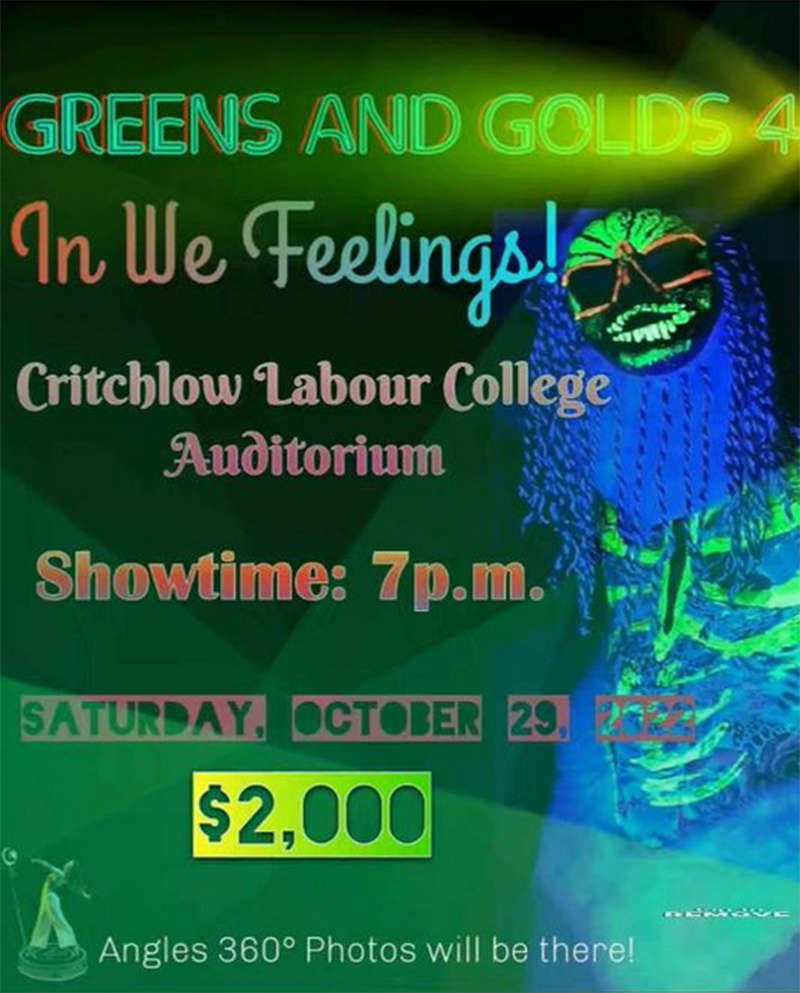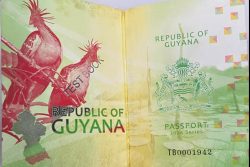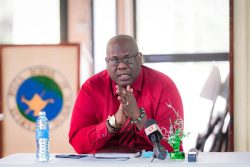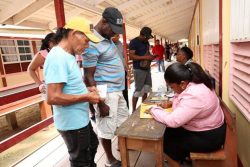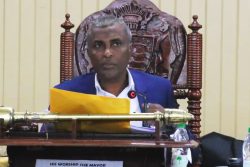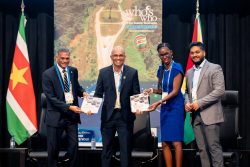 There were recently two theatre productions on the Guyanese stage on the same weekend, standing in contrast to each other in many ways, and bringing to notice a number of significant features of the present time. Signature Productions returned with “Nothing to Laugh About,” directed by Maria Benschop at the National Cultural Centre (NCC) while Kreative Arts reopened its annual productions with “Greens and Golds 4: In We Feelings”, directed by Jonathan and Esther Hamer and staged at the Critchlow Labour College.
There were recently two theatre productions on the Guyanese stage on the same weekend, standing in contrast to each other in many ways, and bringing to notice a number of significant features of the present time. Signature Productions returned with “Nothing to Laugh About,” directed by Maria Benschop at the National Cultural Centre (NCC) while Kreative Arts reopened its annual productions with “Greens and Golds 4: In We Feelings”, directed by Jonathan and Esther Hamer and staged at the Critchlow Labour College.
It rarely ever happens that a Georgetown theatre-goer has a choice of two different performances on the same night. To go further, it was a pleasant surprise that one was able to compete with the other. Signature is an established professional company accustomed to huge box office successes and it offered “Nothing to Laugh About” number 13, signifying more than 13 years of one of the most popular comedic productions in Guyana. Kreative Arts is a small developing company, several of whose performers are youths and dance students, offering quite a different brand of theatre. “Greens and Golds 4: In We Feelings” was not popular comedy. Yet, the Critchlow Labour College auditorium was filled to capacity, because the show attracted an audience larger than ever seen in three years it was held at the smaller Theatre Guild Playhouse.
Kreative Arts’s main interest is dance and, among other things, it is a dance school for children and youths; the public performances show off the results of their training. They exhibit the creative stage work of three age groups: Debutante 1, Debutante 2, Debutante 3 and of the Adults in the company. Apart from the annual production, the students are at a point where they are able to provide a good quality of performance items for different shows at any time.
The first director is Jonathan Hamer, dancer, choreographer, actor and stage technician, who is also an Associate Member of the National Drama Company. Esther Hamer is the second director. A dancer, actress, director, designer and dance teacher, she is the lead choreographer for the National Drama Company and a tutor at the National School of Theatre Arts and Drama. They were responsible for the production and stage direction of the October 29 performance.
The question of survival becomes relevant. Greens and Golds is one of the many annual productions that have emerged, and it has resurfaced after the pandemic closure. That is to its credit, but also that it has persevered in a climate where it has become more difficult to stage public performances mainly because of the rising costs of production and unreliable audience numbers. Ticket sales have declined over the years and a number of theatre producers have been driven out. Production costs and low audience numbers pose a challenge, and Kreative Arts has shown resilience and effective promotional effort in its achievement of a larger house after COVID-19, while all others have recorded reduced audience numbers.
The choice of performance venue is another factor of survival. Performing at Critchlow might well have been a response to the fact that both the major venues – the NCC and the Theatre Guild have increased their rental fees, making production more prohibitive. We have seen the use of unconventional and sometimes unsuitable venues, such as the Girl Guides Pavilion used by Lloyd and D’Arts, and now the auditorium at Critchlow Labour College. But once more to the credit of Kreative Arts, the Critchlow venue was made to work.
An ordinary hall with a standard platform stage was transformed into a theatre with imaginative use of performance space. The flat floor space, the doors, steps and a well-used set were called into service to produce dramatic effect. The most spectacular achievement was the climbing of Mount Roraima. The programme had two major divisions: a first half where the prevailing theme was patriotism, and a second half dominated by dance. Most of the items in the First Act were devoted to praise of Guyana, to nationhood and national vows. The national flag served as a motif and recurring symbol in many of them. The flag itself appeared in its flowing glory in scenes depicting the military and the armed forces, and especially in the conquest of Mount Roraima. The dramatic and spectacular high point was the use of the set to play out the memorable climbing of the mountain by a performer who, acting the part of a member of the armed forces, planted the national flag at the summit.
The very title of the show – Greens and Golds – is an indication of this dedication to nationhood, since it is taken from the national colours, which were also often thematically used in the performance. This patriotic motif was obvious in the placement of the national anthem as an item in the show, rather than being left as the ceremonial opening as is customarily done. Guyana’s independence was proclaimed, both in memory of the political event and in assertion of identity. National songs abounded as the music for items, as well as spoken word and titles for items, such as “Guyana the Free”, “The Golden Arrowhead”, “I Am A Guyanese” and “We Welcome Independence”.
This national tribute carried over into other sides of the programme. The performance was predominantly musical with a particular choice of music to accompany most items. Every song featured was a selection from Guyanese music – all pieces were by local composers and singers – as if to pay tribute to Guyanese musicians. The infinite variety moved across calypso, soca, traditional and soul and paid homage to icons including the Mighty Intruder, Sammy Baksh, Tennicia De Freitas and the Yoruba Singers. Some of these were effective to drive dance of a variety of types. The most outstanding of these was “Baking Pone” to the music of Baksh’s legendary “To Be Lonely”, a hit from the 1970s. This dance, choreographed by Jonathan Hamer who also performed the lead, was supported by Esther Hamer and a chorus. It was memorable in its capture of mood and expression of pathos, enhanced by dramatic costuming and lighting.
Effective lighting, however, was a hallmark of the whole show and another characteristic of the way the directors made the most of an unconventional venue. There were enough lights to be creatively exploited, and that was the case in “Greens and Golds”.
The same can be said for the use of sound. There was no problem with audibility, and sound reproduction was rich and effective, which spoke to how the directors adapted the venue to support dramatic performance. It was reminiscent of the continuing problems with inconsistent and faulty sound due to equipment malfunction at the NCC, which also has similar issues with lights. Recent lighting blemishes at the Theatre Guild were also remembered when one took into consideration how the limitations of Critchlow were adequately managed in this production.
Several other dances were shaped by soca, with some of the lively and prominent local compositions accompanying a number of notable performances in popular dance. The items flowed and there was quite an uninterrupted pace, particularly among the dances, since the show adopted the style of items running without announcement or the intervention of an MC. The show therefore benefitted from expert management and technical services provided by Ayanna Waddell, another NDC member, as stage manager.
It was ironic to see how a production demonstrating how an ordinary assembly hall can be reshaped into a theatre capable of dramatic production quite likely ended up at that venue because of high costs at the Theatre Guild where it had staged all its previous performances before 2020. It was ironic that the production was so resounding in patriotic sentiment at the same time when it, like others of its type, made it to the stage in the face of so many odds relating to the rising costs of production. But it was good to see the manner in which it turned those odds to advantage in a production that was exemplary in its perseverance.
